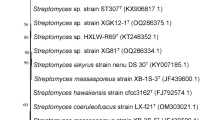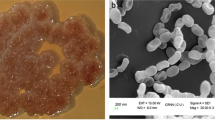Abstract
Two closely similar strains of a new species of Streptomyces (Nos. 1033 and 1038) were isolated from the Champavathi river mud (Andhra Pradesh) and Bangalore virgin soil (Mysore State). Their morphological and biochemical characteristics (Table 1) appear similar to those of Streptomyces viridans (Waksman and Henrici's classification)1, but they are readily differentiated from the latter by the formation of straight sporophores and aerial mycelium in circles and tufts, and the elaboration of antifungal substances.
This is a preview of subscription content, access via your institution
Access options
Subscribe to this journal
Receive 51 print issues and online access
$199.00 per year
only $3.90 per issue
Buy this article
- Purchase on Springer Link
- Instant access to full article PDF
Prices may be subject to local taxes which are calculated during checkout
Similar content being viewed by others
References
Waksman, S. A., and Lechevalier, H. A., “Actinomycetes and their Antibiotics” (Williams and Wilkins Co., 1953).
Waksman, S. A., Bact. Rev., 21, 1 (1957).
Oroshnik, W., et al., Science, 121, 147 (1955).
Amman, A., and Gottlieb, D., App. Microbiol., 3, 181 (1955).
Author information
Authors and Affiliations
Rights and permissions
About this article
Cite this article
RAO, P., UMA, B. Formation of Antifungal Antibiotics by a New Streptomyces Species. Nature 182, 115–116 (1958). https://doi.org/10.1038/182115b0
Issue Date:
DOI: https://doi.org/10.1038/182115b0
Comments
By submitting a comment you agree to abide by our Terms and Community Guidelines. If you find something abusive or that does not comply with our terms or guidelines please flag it as inappropriate.



